 The Dwyer team recently released the StabiliSENSE™ critical room pressure monitor, Series RPMC. This series is ideal for critical low differential room pressure applications, such as: clean manufacturing areas, semiconductor manufacturing, pharmaceutical, clean rooms, research labs, and vivariums. Continue reading “[New Product Highlight] StabiliSENSE™ Critical Room Pressure Monitor | Series RPMC”
The Dwyer team recently released the StabiliSENSE™ critical room pressure monitor, Series RPMC. This series is ideal for critical low differential room pressure applications, such as: clean manufacturing areas, semiconductor manufacturing, pharmaceutical, clean rooms, research labs, and vivariums. Continue reading “[New Product Highlight] StabiliSENSE™ Critical Room Pressure Monitor | Series RPMC”
Ensuring HVAC System Safety for Reopening Schools & Office Buildings
 The current COVID-19 pandemic spread and breadth is unprecedented. Because of this, it is important that precautions are taken when reopening schools and office buildings. The question we find ourselves asking as professionals in the HVAC trade is this:
The current COVID-19 pandemic spread and breadth is unprecedented. Because of this, it is important that precautions are taken when reopening schools and office buildings. The question we find ourselves asking as professionals in the HVAC trade is this:
How do you return the HVAC system back to normal operations (and continued operations) during this pandemic? Continue reading “Ensuring HVAC System Safety for Reopening Schools & Office Buildings”
What Are Room Pressure Monitors and Where Are They Used?

Room pressure monitors are devices that monitor differential pressure between two rooms or areas. Differential pressure is the difference of two pressures being sensed.
There are several applications where it is important to maintain a pressure difference between two rooms. This helps to ensure that there are no contaminants entering or exiting a protected area. In a medical setting, an isolation room requires a pressure differential to make sure that no bacteria, pathogens, or viruses enter (or leave) the isolation room. This protects healthcare professionals, patients, and other guests, and minimizes the spread of germs. Room pressure monitors would also be used in areas such as: pharmaceutical manufacturing, semiconductor manufacturing, clean rooms, research labs, vivariums, and clean manufacturing areas. Continue reading “What Are Room Pressure Monitors and Where Are They Used?”
How to Program a Switch for Manual Reset

Several applications require manual reset switches, which are switches that need to be physically reset by an individual for a process to continue or restart. A manual reset is often needed when an area has to be inspected prior to equipment restart. This can help to ensure the safety/inspection of both equipment and other individuals in the area.
Some switches have a mechanical manual reset (such as the Dwyer Series 1900, 1831, and 1800). However, there may be a need to have a manual reset for applications beyond what these switches are designed for. If a pump is allowed to run with a clogged filter, for example, this may severely damage the pump. Continue reading “How to Program a Switch for Manual Reset”
ISO/IEC 17025 Calibration in Food and Agriculture
World Accreditation Day
Yesterday (June 9, 2020) marked this year’s World Accreditation Day, which is a global initiative established by the International Laboratory Accreditation Cooperation (ILAC) and the International Accreditation Forum (IAF) to promote the value of accreditation.
 This year’s focus was on how accreditation improves food safety, supporting the confidence of consumers, suppliers, purchasers, regulators and specifiers in the quality and safety of food [1]. When it comes to ensuring food safety, consumers and suppliers rely on their equipment and calibration providers to comply with the appropriate international standards, such as ISO/IEC 17025:2017.
This year’s focus was on how accreditation improves food safety, supporting the confidence of consumers, suppliers, purchasers, regulators and specifiers in the quality and safety of food [1]. When it comes to ensuring food safety, consumers and suppliers rely on their equipment and calibration providers to comply with the appropriate international standards, such as ISO/IEC 17025:2017.
 Attaining accreditation status to ISO/IEC 17025:2017 is a rigorous process that ensures that the technical competence of personnel, the ethics of personnel, and the reliability of the organization itself are at a level that can be recognized on an international scale. The Dwyer Instruments, Inc. Engineering Laboratory is proud to be able to provide ISO/IEC 17025:2017, ANSI/NCSL Z540-1-1994 and ANSI/NCSL Z540.3 Section 5.3 accredited calibrations on pressure products that are used in these critical food safety environments. Continue reading “ISO/IEC 17025 Calibration in Food and Agriculture”
Attaining accreditation status to ISO/IEC 17025:2017 is a rigorous process that ensures that the technical competence of personnel, the ethics of personnel, and the reliability of the organization itself are at a level that can be recognized on an international scale. The Dwyer Instruments, Inc. Engineering Laboratory is proud to be able to provide ISO/IEC 17025:2017, ANSI/NCSL Z540-1-1994 and ANSI/NCSL Z540.3 Section 5.3 accredited calibrations on pressure products that are used in these critical food safety environments. Continue reading “ISO/IEC 17025 Calibration in Food and Agriculture”



